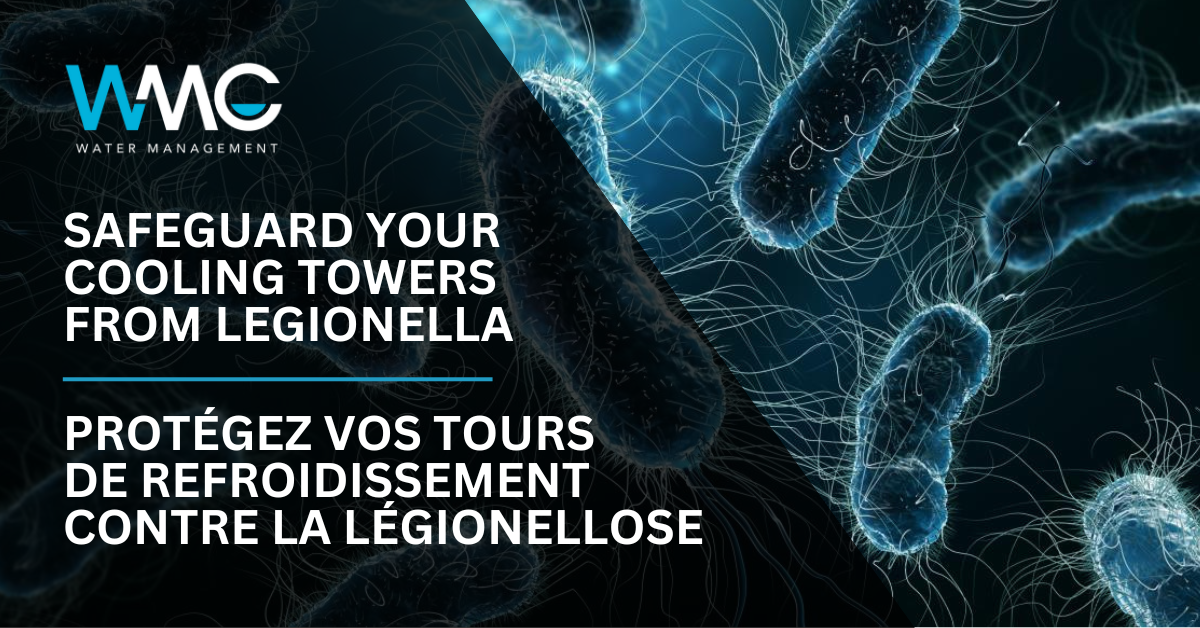
Safeguard Your Cooling Towers from Legionella | WMC Water
Legionella is a group of pathogenic bacteria that can cause Legionnaires’ disease, a serious and potentially fatal pneumonic respiratory illness.
Legionella bacteria are found in natural surface water and groundwater systems. They are also present in building water piping and can proliferate within these systems under the right conditions. When this occurs, possible human exposure to water containing Legionella bacteria can result in public health concerns due to the risks associated with Legionnaires’ disease.
Possible sources of Legionella bacteria include heating water systems, drinking fountains, showers, sink faucets, humidifiers, decorative water features and cooling towers. The bacteria grows naturally in the water that supplies these systems, and conditions such as warm temperatures, stagnation and the presence of nutrients can lead to rapid growth.
When discussing Legionella and water safety, it is important to understand that Legionnaires’ disease is a waterborne pathogen. The bacteria can only infect a person who aspirates (inhales) contaminated water droplets. Fortunately for us humans, this means that Legionnaires’ disease is preventable in the vast majority of cases, as long as we take the correct course of action to protect the public from exposure to contaminated water.
Cooling towers used for heat rejection in human-occupied buildings are considered a major risk point for waterborne pathogens due to the large volumes of water that they can evaporate.
It’s essential to have a comprehensive strategy for minimizing Legionella risks in cooling towers to ensure a healthier building environment.
“Be sure that your Legionella risk management strategy includes a Water Safety Plan outlining the treatment methods, protocols and monitoring that you will employ to minimize the risks associated with legionellosis in your cooling towers and other water systems in your building.” - John Damiani, P.Eng., General Manager, WMC Water Management
Start with a Plan
The first step of any Legionella risk management strategy is to form a Water Safety Team and develop a Water Safety Plan. Members of the Water Safety Team should be certified under ASSE/IAPMO/ANSI 12080, Professional Qualifications Standard for Legionella Water Safety and Management Personnel. As your full service water treatment partner, WMC will take an active and leading role on the team and use our expertise to help you develop a comprehensive Water Safety Plan for your facility.
Great Program, Great Service, Great Results
Each open cooling system should have a properly implemented Water Treatment Program that includes precise automatic bleed control to maintain consistent cycles of concentration, and an acceptable biocide program to control microbial activity.
A good starting point is a two-stage biocide program employing one oxidizing and one non-oxidizing biocide. The oxidizing biocide should be fed using a live automated control method such as ORP (oxidation-reduction potential). The non-oxidizing biocide can be fed proportionally based on system makeup or slug dosed using a timer, depending on system operating conditions.
The optimal approach will depend on the particulars of each system. WMC can evaluate your existing Water Treatment Program and help you bring it up to current standards, or design and engineer a new program from the ground up.
Consistency is Key
A Water Treatment Program might look great on paper, but does it deliver reliable results day-in and day-out? Controlling micro-organisms in cooling towers is all about consistency. Despite even the best laid plans, legionellosis outbreaks can occur in systems following interruptions or upsets which cause a temporary lapse or failure of the biocide control program. This is a critical and often overlooked component of Legionella risk management that needs to be accounted for in your Water Safety Plan.
Test… and Be Ready to React
While testing alone does not do anything to prevent bacteria growth, an appropriate Legionella testing regimen is an important verification measure.
Ensure that the testing program includes regular ISO 11731:2017 culture analysis to enumerate L.pneumophila by serogroup. Other testing methods can be employed supplementally as appropriate, as long as their limitations are understood by the Water Safety Team.
The most important consideration regarding testing is to be prepared to respond swiftly when test results indicate that corrective action is required. The response plan will typically have multiple action levels depending on the test results, which can range from adjusting biocide feed rates and increasing monitoring to full system shutdown and emergency sanitization procedures.
“When it comes to Legionella, don’t test without having a response plan in place.”
- Elmer Palapal, Service Technician, WMC Water Management
A Clean Start, Every Time
Cooling tower systems are at the highest risk of microbiological contamination during initial startup after a prolonged shutdown or standby situation. An effective pre-operational sanitization procedure executed by qualified professional technicians is a crucial component of any Water Safety Plan.
Pay attention to dead-legs and low-flow areas where bacteria can proliferate easily, and ensure that visual internal waterside inspections are incorporated into cooling tower startup and shutdown procedures to look for signs of biofilm formation.
Don’t limit sanitizations to startup only. Depending on system conditions, additional sanitization procedures may be appropriate following system upsets, construction work or sub-optimal test results. As your partner in Water Safety, you can rely on WMC’s expertise to determine when additional sanitization procedures are recommended.
“Using a practical approach that employs automated bleed control, proper biocide feed, testing, regular maintenance and sanitizations, you can significantly reduce the risk of Legionella in your cooling towers, ensuring a safer and healthier environment for your building and its visitors/occupants.” - Micah Thomson, P.Eng., Technical Service Manager, WMC Water Management
For professional help with Legionella testing, your Water Management Program, or developing a Water Safety Plan for your facility, contact us.
Contact us today to get started.
Toronto | Ottawa | Kingston | Quebec
Related Articles
Cooling Towers & Legionella: How Scale & Corrosion Drain Your Budget
Cooling towers are the backbone of many commercial, institutional, and industrial buildings across...Keeping Building Systems Running Smoothly Across Ontario & Quebec
Water touches every part of a building’s performance. From heating to cooling to day-to-day...

